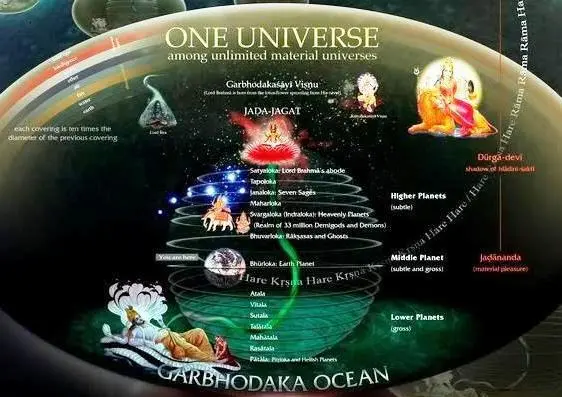
Exploring the Gods in Hinduism
Hinduism, one of the world’s oldest and most diverse religions, boasts a vast and intricate pantheon of deities. This rich tapestry of gods and goddesses forms a complex hierarchy, reflecting the multifaceted nature of Hindu spirituality.
While Hinduism is often described as polytheistic, it is better understood as henotheistic, as it acknowledges the existence of many gods while emphasizing devotion to a single, supreme reality, Brahman.
In this article, we will explore the hierarchy of gods in Hinduism, from the supreme deity down to the various manifestations and avatars.
Brahman – The Supreme Reality
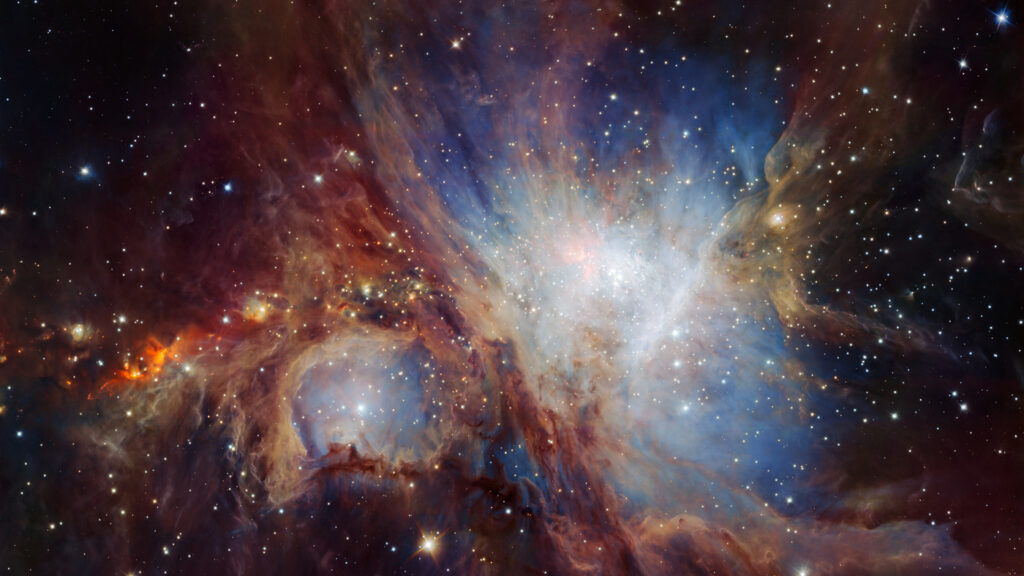
At the pinnacle of the Hindu divine hierarchy stands Brahman. This transcendent and formless entity is often described as the ultimate, unchanging reality from which everything emanates. Brahman is the source and essence of the entire universe, and all other deities in Hinduism are seen as manifestations or aspects of this supreme reality.
So people can get confused Brahman with Brahma, though they are completely different. Brahma is a manifestation of Brahman, Brahma has a form whereas Brahman is formless.
Every deity and devta is the manifestation of the Brahman. To understand better you can say Brahman is the sea and the sea waves that arise from it is the manifestation of the deities.
In old scriptures Brahma is shown to have emotions and feelings whereas Brahman does not feel anything as it is formless.
Another confusion could arise as Brahman is also called a class of people in India, in olden times Brahman people used to perform all the worship related tasks in India.
Trimurti – The Three Principal Deities
The Trimurti is a crucial concept in Hinduism, representing the three principal deities responsible for the creation, preservation, and destruction of the universe:
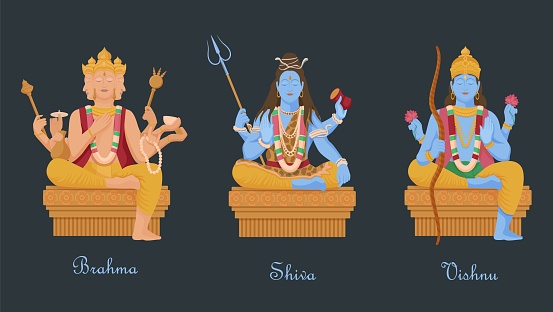
a. Brahma: Brahma is the creator god and is often depicted with four heads, each facing a different direction. He is responsible for shaping the universe and giving life to all beings.
Brahma’s four heads represent the four Vedas and the four caridnal directions. The four Vedas are Rigveda, Yajurveda, Samaveda and Atharveda. In each universe there is a Brahma.
b. Vishnu: Vishnu is the preserver god, responsible for maintaining order and balance in the universe. He is often depicted with blue skin and has several avatars, including Rama and Krishna.
c. Shiva: Shiva is the destroyer god, but he also represents regeneration and transformation. He is known for his role in ending the cosmic cycle and preparing for a new creation. Shiva also represents time.
In Hindu believes Shiva is known as the MAHA-KAAL (the god of time). Here KAAL represents time.
Hinduism says that there are multiple universes and in each universe there is a trimurti present in them which control that universe.
Devi / Shakti – The Divine Feminine
Devi, meaning “goddess,” represents the divine feminine in Hinduism. She is often considered the mother of all creation and is worshipped in various forms such as Durga, Lakshmi, and Saraswati.
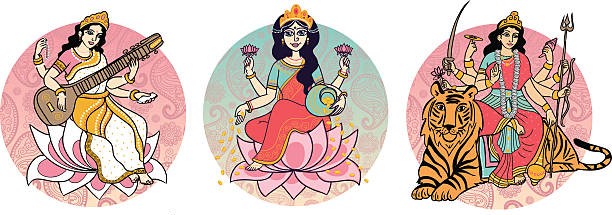
Devi embodies different aspects of feminine power, including motherly love, wealth, and knowledge. Devi is also known as SHAKTI which represents huge power and especially movement. Anything in the universe which is constantly changing and moving is because of SHAKTI
There are fierce forms of shakti as well as the kind, loving motherly form SHAKTI. Kaali is a very fierece form of shakti which also represents time. In India people call her as Kaali ma (ma stands for mother).
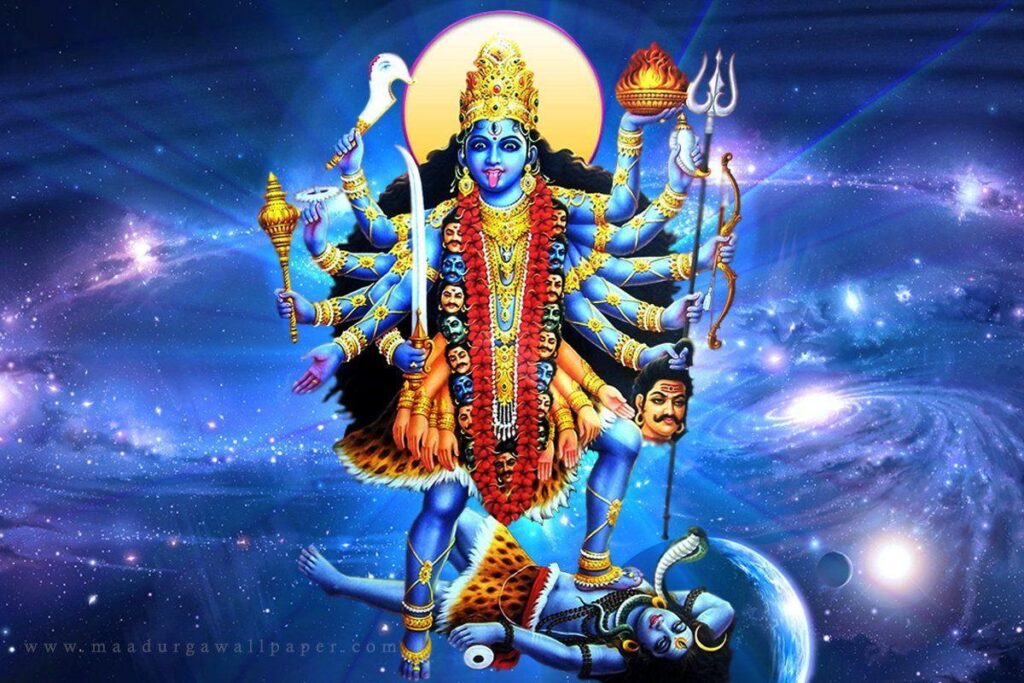
Maa Kaali when takes form, she spares no one. This also represents that time spares no one whether you are good or bad.
Devatas and Devas – Lesser Deities
Beneath the Trimurti and Devi, Hinduism acknowledges a vast array of lesser deities known as devatas (goddesses) and devas (gods). These deities oversee specific aspects of life, nature, and the cosmos. Some well-known devas include:
a. Ganesha: The elephant-headed god, Ganesha, is revered as the remover of obstacles and the patron of intellect and wisdom. Ganesha also symbolises aadhyatam which means spirituality, his long nose is representative of that. Ganesha rides a mouse which in scriptures is known as MOOSHAK .
b. Hanuman: Hanuman is a god which represents the monkeys and symbolizes loyalty, strength, and devotion. If you ever read the RAMAYANA, Hanuman’s devotion to Ram is very beautiful.
c. Indra: Indra is the god of thunder and rain, responsible for ensuring a fertile and prosperous earth. Indra is also like chief of the devtas. He has a parliament like structure in Devlok and the Devtas are like cabinet ministers and after a certain period of time the cabinet ministers as well as the chief gets changed. Indra has immense powers. Indra rides on a white elephant and has a very powerful weapon in his hands known as the VAJRA.
d. Agni: Agni is the god of fire and serves as the intermediary between humans and the gods during rituals. Any holy ritual in India starts with worshipping of Agni in the form of YAGNA. In YAGNA food items are offered to fire god AGNI by placing them in the HAVAN KUND (a structure where the YAGNA fire is there)
e. Surya: Surya is the sun god, representing the life-giving and illuminating force in the universe.
Agni, Surya are also Vedic gods. In vedic period people use to worship all the natural elements and treat them as gods.
Avatars – Incarnations of the Divine
Hinduism teaches that deities can take on human or animal forms to descend to Earth and fulfil specific purposes. These divine incarnations, known as avatars, often serve to restore cosmic order and guide humanity. Vishnu, in particular, is famous for his ten principal avatars, including Rama and Krishna.
Avatars purposes could also be to teach a lesson to humanity or to restore balance on earth. When Vishnu took avatar in the form of KRISHNA, he gave lessons in which is now compiled in the form of Hindus holy book known as the BHAGWAT GEETA.
The life lessons from BHAGWAD GEETA are still applicable and useful in modern times. Everyone once in their life should read BHAGWAD GEETA.
Rishis and Sages
Hinduism acknowledges the importance of spiritual teachers and sages known as rishis. These enlightened beings are revered for their wisdom and contributions to the scriptures, known as the Vedas. Rishis are not gods themselves but are highly respected figures who played a significant role in shaping Hindu philosophy and spirituality.
Rishis were highly knowledgeable people who knew how to shape the society. The most highly of them were SAPTARISHI (THE 7 RISHIS). Hindus believe that everyone on this earth is a lineage of one of these rishis. Bhagwan Shiva has also given knowledge to each of these rishis.
Lokas – The Cosmic Realms
According to Hindu cosmology, the universe is divided into various lokas, or cosmic realms. These realms are inhabited by gods, demigods, celestial beings, and other supernatural entities. The most prominent lokas include:
a. Swarga Loka: The heavenly realm, ruled by gods like Indra, where virtuous souls enjoy the rewards of good karma.
b. Bhuloka: The earthly realm where humans reside.
c. Patala Loka: The subterranean realms inhabited by various demons and serpentine beings. Pataloka is believed to be under the earthly realm.
d. Kailasa: The abode of Lord Shiva, often depicted as a mythical mountain, where he resides with his consort Parvati. Hindus also believe that the KAILASA mountain is which is on China borders is the abode of Shiva. The chinese government has also banned climbing on it due to religious reasons.
Ishta Devata – Personal Deities
Hinduism allows individuals to choose a specific deity as their “Ishta Devata” or personal deity. This deity is often selected based on personal inclinations, familial traditions, or specific needs in one’s life. Devotees develop a strong bond with their chosen Ishta Devata, fostering a deep sense of connection and devotion.
Like for young kids in India, Hanuman is generally their ISHT DEVATA by their liking. Hanuman is seen as a superhero in young kids. Also worship of Hanuman is recommended for those who are suffering from evil eyes.
Syncretism and Local Deities
One of the unique features of Hinduism is its ability to incorporate local and regional deities into its pantheon. Throughout India, various communities worship their own gods and goddesses, who are often seen as manifestations of the larger Hindu pantheon. This syncretic approach has led to a diverse and inclusive religious landscape.
If you have watched a movie named “Kantara”, in that movie a festival named as Bhoota Kola is celebrated. In this festival it is believed that the local deity of that area comes inside a person of that village and blesses everyone. Bhoota Kola is celebrated in the southern part of India esp in Karnataka.
Bhakti and the Personal Relationship with the Divine
Bhakti, the path of devotion, is a central aspect of Hinduism. It emphasizes a personal and emotional connection with the divine, transcending the boundaries of hierarchy. Devotees cultivate a loving relationship with their chosen deity, believing that sincere devotion can lead to spiritual liberation.
The hierarchy of gods in Hinduism is a multifaceted and dynamic system that reflects the diverse nature of the religion.
From the supreme reality of Brahman to the various levels of deities, avatars, sages, and cosmic realms, Hinduism provides a comprehensive framework for understanding the divine. It encourages personal devotion, fosters spiritual growth, and accommodates a wide range of beliefs, making Hinduism a profoundly inclusive and vibrant religious tradition.
Hinduism is a home for everyone in the universe regardless of it’s nature and form.
Namastey